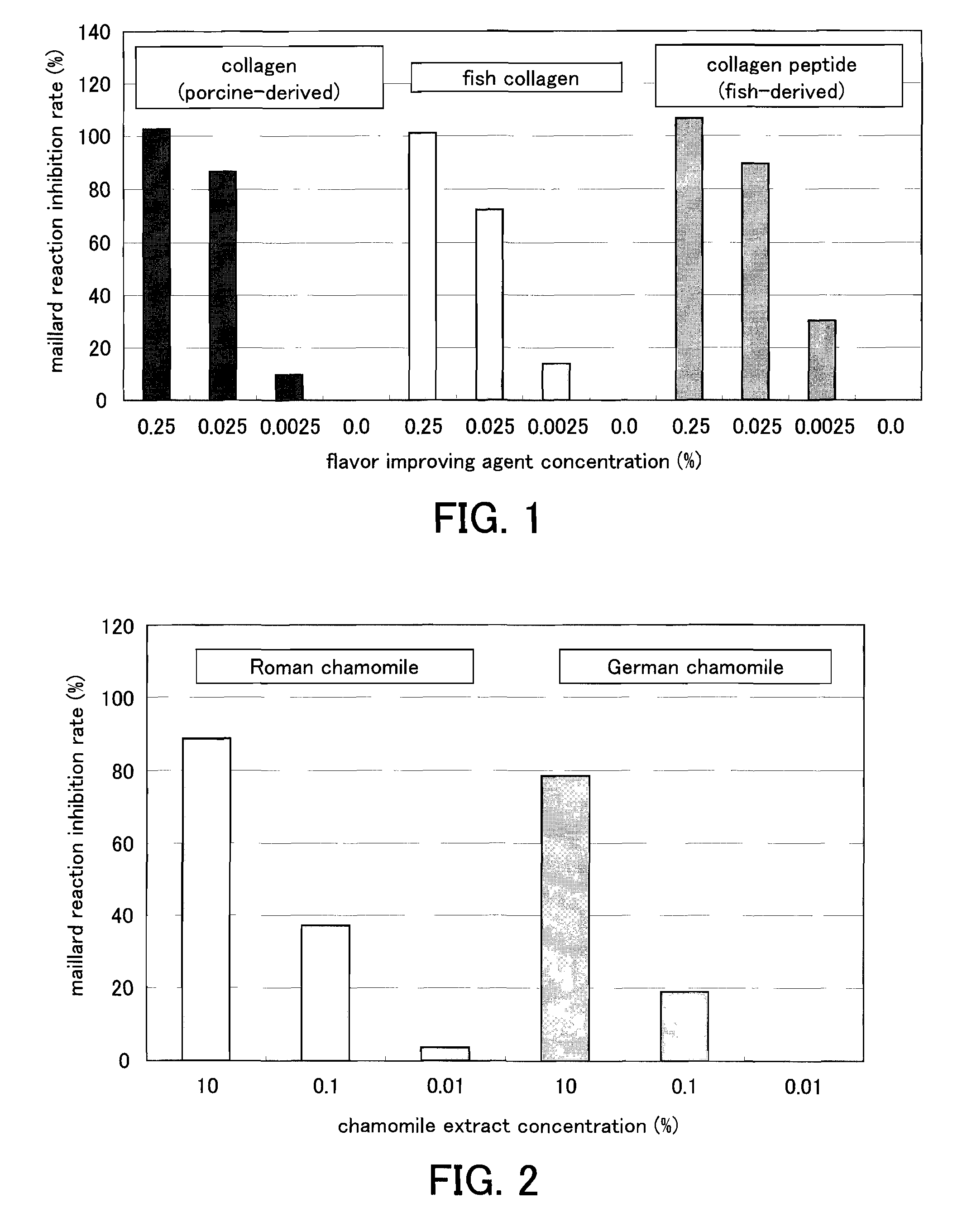Flavor improving agent for food and beverage
a technology of flavor improvement agent and food and beverage, which is applied in the field of flavor improvement agent for food and beverage, can solve the problems of affecting the flavor and quality the manufacturing process may be complicated, so as to achieve the effect of suppressing the smell of food and beverage, and suppressing the generation of aforementioned smell components
- Summary
- Abstract
- Description
- Claims
- Application Information
AI Technical Summary
Benefits of technology
Problems solved by technology
Method used
Image
Examples
example 1
[0045]The flavor improving agent of the present invention was added to collagen beverage, and suppression of the change in flavor due to heat and storage was confirmed.
Preparation of Flavor Improving Agent
[0046]Dry materials of Roman chamomile (anthodium), dokudami (aerial part), Midland hawthorn (fruit), and grape (leaf) are mixed such that each material has an equal amount (weight). This dry mixture (100 g) was soaked in purified water (10 L) at about 80° C. for about 5 hours. Thereby, a plant extract of the dry mixture was extracted. This extract was filtrated to remove residue and filtrate (about 10 kg) was collected. The filtrate further was dried to remove solvent (purified water) and 20 g of powder substance was obtained. The powder substance was mixed with diluting agents (dextrin, starch, calcium stearate, silicon dioxide, caramel pigment, titanium dioxide, soy-derived lecithin) and a solid flavor improving agent was obtained.
Preparation of Collagen Beverage
[0047]Collagen b...
example 2
[0058]The flavor improving agent of the present invention was added to fish, and the flavor of fish was confirmed. The flavor improving agent prepared in Example 1 was used as the flavor improving agent in Example 2.
Confirmation of Change in Flavor
(1) Soaked in Flavor Improving Agent Before Heating
[0059]A flavor improving agent solution was prepared by dissolving the flavor improving agent in water such that a concentration of the flavor improving agent becomes 1% (w / v). Shishamo (Spirinchus lanceolatus, dry) and Japanese anchovy (Engraulis japonica, raw) respectively were soaked in the flavor improving agent solution at room temperature of 20° C. for 10 minutes. After soaking, the fishes were drained and grilled for 10 minutes. The thus-obtained fishes were referred to as Example 2-1. Further, fishes soaked in water instead of the flavor improving agent solution were grilled in the same manner. The thus-obtained fishes were referred to as Comparative Example 2-1. The flavor of thes...
example 3
[0068]The flavor improving agent of the present invention was added to rice bran pickle, and the flavor of rice bran pickle was confirmed. The flavor improving agent prepared in Example 1 was used as the flavor improving agent in Example 3.
Confirmation of Change in Flavor
(1) Addition of Flavor Improving Agent to Rice Bran Bed
[0069]The flavor improving agent was incorporated into a rice bran bed such that a concentration of the flavor improving agent becomes 1% (w / v). Cucumber was pickled in the rice bran bed at 10° C. for 7 days. Thereafter, cucumber was picked up from the rice bran bed and the flavor of the rice bran pickle was confirmed after washing it with water. The thus obtained rice bran pickle was referred to as Example 3-1. Further, cucumber was pickled in the rice bran bed, to which the flavor improving agent was not incorporated, and the flavor of the rice bran pickle was confirmed in the same manner. The thus-obtained rice bran pickle was referred to as Comparative Examp...
PUM
 Login to View More
Login to View More Abstract
Description
Claims
Application Information
 Login to View More
Login to View More - R&D
- Intellectual Property
- Life Sciences
- Materials
- Tech Scout
- Unparalleled Data Quality
- Higher Quality Content
- 60% Fewer Hallucinations
Browse by: Latest US Patents, China's latest patents, Technical Efficacy Thesaurus, Application Domain, Technology Topic, Popular Technical Reports.
© 2025 PatSnap. All rights reserved.Legal|Privacy policy|Modern Slavery Act Transparency Statement|Sitemap|About US| Contact US: help@patsnap.com

